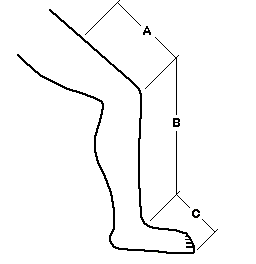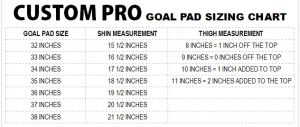The proper height of goal pads is crucial. If the pads are too tall it will impede one’s side to side movement and mobility. If too short, you will be vulnerable to injury in the knee and lower thigh area and provide less coverage. Although there is no exact set height a goal pad should be on one’s leg, the following are guidelines which, when followed, will ensure a proper fit.
Generally speaking a good rule of thumb is that the knee, when slightly bent, should be centered in the middle knee roll. For a conventional pad, the highest portion of the pad should be half to two thirds up the thigh from the knee. This will allow proper mobility for skating and maneuvering around the net. For the newer box style you often see +1″ or +2″. This refers to measuring as described above but with added height to the top section of the goal pad, also referred to as the “thigh rise”. For this type of goal pad the thigh measurement can be three quarters up from the knee. Goaltenders with a wider stance or who can handle the extra height will benefit by being able to have a smaller five hole. Most goalies can handle the +1″ and if you are are on the taller side, say six foot, you may be able to handle the +2″. Today’s goal pad design is not unlike a blocker where you basically have a board on front of your leg and instead of a palm, there is a cradle system to secure the pad to your leg. And since the pad is relatively flat and usually sits away from your thigh, you can wear a taller pad without having it interfere with your play.
There are variables that should be taken into account. The following are some items that should be discussed after the initial measuring. Included is a brief explanation afterwards.
- Is the person still growing?
You may want to make sure that the pads are slightly on the taller side to allow for growth.
- What style of play do you primarily use if playing with the more common box style of goal pad?
Today’s pad is designed to benefit the butterfly goaltender. To maximize the benefit of this type of pad, look for one with a more squared off top and toe. The square toe will start the rotation of the pad sooner thus maximizing the blocking surface. The squared top will help close up the five hole when butterflying and if you’re one for forgetting to keep the blade of your goalie stick flush between your pads, you will also benefit with a more squared off top. If you are more of a stand up goaltender or just go down when the need arises, a pad with slightly more rounded edges would be fine. Either shape can be used effectively no matter what style you use. Some designs can enhance a certain style.
- What style of play do you primarily use if playing with a conventional goal pad?
For a butterfly style you want a longer and tapered toe with the top of the pad rounded and flexible. For a stand-up style you may want a more squared toe and top for more frontal coverage. If one plays a combination of both of these styles you might look for a pad with good flexibility, slightly rounded and/or angled tops with a nicely tapered toe. Any type of goal pad can be used for either style of play without any major problems. Some are more conducive to certain styles of play.
- Do you like a smaller of taller goal pad?
Some do have a preference so you should take this into account when sizing.
Here are guidelines to properly size yourself for a set of goal pads. Have the goaltender in his stance or be sitting down with your feet flat on the floor and knee bent. With a cloth measuring tape, measure the following.
- From the tip of your shoe or toe to your instep (where the bow would be when you tie up your shoe), dimension C.
- From your instep (where the bow would be when you tie up your shoes) to the center of your knee cap, dimension B
- From the center of your knee cap to the desired height up the thigh, dimension A. Don’t forget to take into account the items discussed above.
With these measurements you can go to the chart below and see which size of goal pad would be suitable.
| PREMIER (BOX style)
GOAL PAD SIZING CHART |
||
|
GOAL PAD SIZE |
SHIN MEASUREMENT |
THIGH MEASUREMENT |
|
32” |
15 ½” |
7 inches = 2 inches off the top |
|
33” |
16 ½” |
8 inches = 1 inch off the top |
|
34” |
17 ½” |
9 inches = 0 inches off the top |
|
35” |
18 ½” |
10 inches = 1 inch added to the top |
|
36” |
19 ½” |
11 inches = 2 inches added to the top |
|
37” |
20 ½” |
|
|
38” |
21 ½” |
|
|
PREDATOR (conventional) GOAL PAD SIZING CHART |
||
|
GOAL PAD SIZE |
SHIN MEASUREMENT |
THIGH MEASUREMENT |
|
32” |
15 ½” |
7 inches = 2 inches off the top |
|
33” |
16 ½” |
8 inches = 1 inch off the top |
|
34” |
17 ½” |
9 inches = 0 inches off the top |
|
35” |
18 ½” |
10 inches = 1 inch added to the top |
|
36” |
19 ½” |
11 inches = 2 inches added to the top |
|
37” |
20 ½” |
|
|
38” |
21 ½” |
|
|
Junior Heritage Goal Pad Sizing Chart |
Senior Heritage Goal Pad Sizing Chart |
||
|
GOAL PAD SIZE |
SHIN MEASUREMENT |
GOAL PAD SIZE |
SHIN MEASUREMENT |
|
27” |
13” – atom |
31” |
14 ½” |
|
29” |
14 ½” – minor peewee |
33” |
16 ½” |
|
31” |
16” – peewee |
35” |
18 ½” |
|
Junior Featherlite Goal Pad Sizing Chart |
|
|
GOAL PAD SIZE |
SHIN MEASUREMENT |
|
20” |
8” |
|
22” |
9 ½” |
|
24” |
11” |
|
26” |
12 ½” |

